From its earliest discoveries in paintings on the walls of Egyptian tombs circa 2680 BC to the present day, roughly seventy true lettuce heirlooms and a mosaic of varieties, make this leafy annual of the aster family far from ordinary. It is great for you, delicious, accessible, easy to grow with varieties to harvest in every season, including summer and winter in Skylands territory. No space for a garden, you say? Not to worry. Lettuce can grow in planters and pots, in a window box, on a roof garden, terrace, “square foot garden,” herb garden, flower bed or raised bed. And it’s packed with nutrients (even Iceberg!) and practically devoid of calories. Read on to see why this humble vegetable is a source of culinary magic and how you can grow your own.
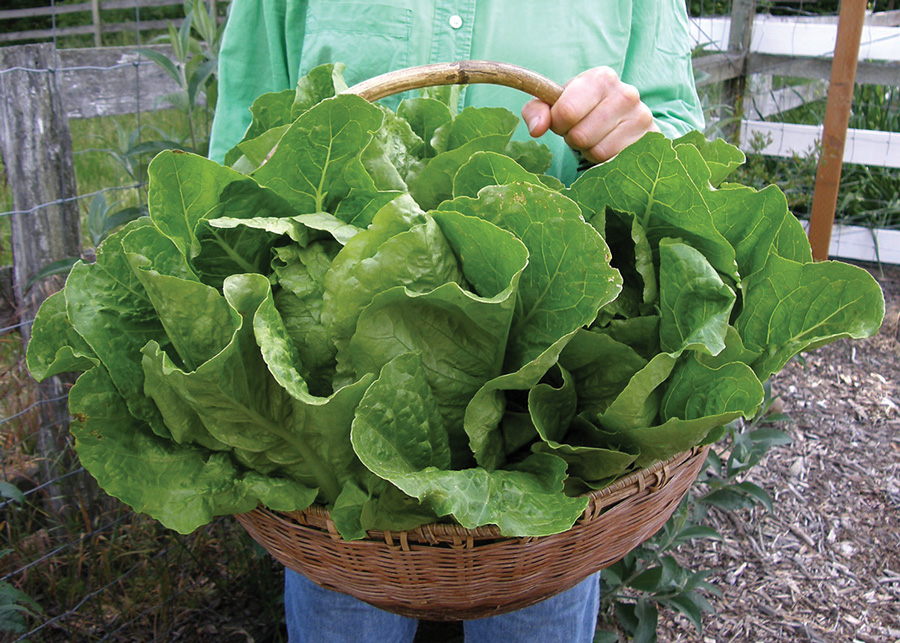
Lettuce (Lactuca sativa), in my opinion, is one of the best vegetables. Eat it raw. Eat it cooked. In sandwiches, on the outside of sandwiches, as a wrap. In soup and casseroles. On tacos. Grill it. Scoop it. Want to lose weight? At only five calories a cup, it takes up space in your body so you can’t eat a pile of pasta or bread. What more can you ask?
All lettuce is open pollinated, including heirlooms (over fifty years old and kept true for a particular region) meaning pollinated by wind and critters. “There are no lettuce hybrids,” says Renee Shepherd, founder and owner of Renee’s Garden Seeds. Shepherd is a passionate gardener, cook, author, and American Horticultural Society award winner as well as purveyor of fine garden seeds. Today, lettuce is one of the biggest sellers from seed catalogs because it is easy to grow and takes up little space in the garden. You can grow it anywhere there’s sun.
In 2017, the U.S. grew thirty-eight tons of lettuce; 90% of it in California and Arizona, according to the Leafy Greens Marketing Agreement. The LGMA is a consortium of farmers, academia and government that ensures the safety of land, crops and consumers by following “science-based food safety practices.” In the early 1900s, 95% of all lettuce grown and consumed in the US was Iceberg. Today, the number one lettuce being sold at market are packaged mixes: Mesclun, Spring, Stir Fry and Baby Leaf. But you can easily grow your own right outside your kitchen door. And it couldn’t be any fresher.
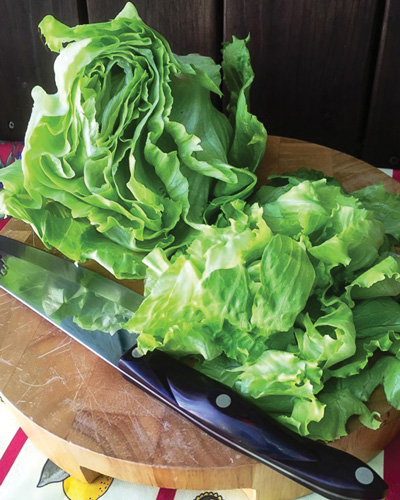
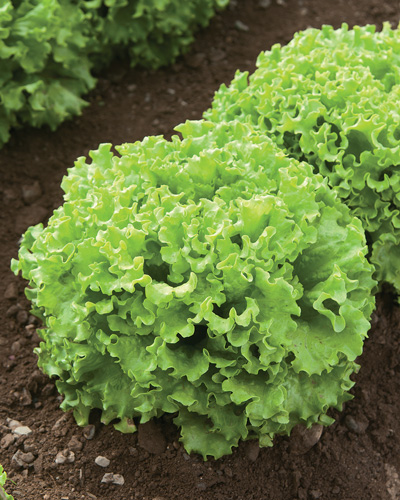
At employee-owned Johnny’s Selected Seeds, lettuce comes two ways: seed as usual and pelleted. Because lettuce seed is so small, the pelleted version is easier to plant individually where you want it to grow. No thinning necessary. There is a clay coating on each seed that must be dissolved before the seed can germinate. If directly planted in the ground, keep it moist. Want to continue harvesting lettuce throughout the summer? Johnny’s recommends Muir, a summer crisp Batavia. Johnny’s website offers invaluable information on all varieties.
You can enjoy a beautiful and bountiful garden even if you don’t have lots of room. Space-saving varieties are specialties at Renee's Garden Seeds with a plethora of container selections and plentiful information. Packets include complete instructions, deemed a must-read by Shepherd before planting, and “Garden Resources” is a litany of tips and videos. Shepherd’s first choice for those with little room are her Cut and Come Again and Baby Leaf Samplers with a variety of flavors, textures and colors. Some contain different lettuces, herbs and other leafy greens such as baby spinach, chard and kale. “They are the fastest, easiest way to grow a salad,” she says. “You’ll have a nice salad and no thinning is necessary. They are perfect for new and small space gardeners and for people who want to grow an instant and delicious salad.” Shepherd’s other choices: Heat-tolerant Jericho Romaine—thin six to eight inches apart; Garden Babies Butterhead—grow five or six in a container; Queen of Crunch or Webb’s Wonder with crunchy loose heads shredded for tacos. Got a crowd to feed or a family picnic? A large head of gorgeous Merveille De Quatre Saisons, brought from Europe by Shepherd, will stun them silly. Plant large loose-leaf types for wraps and red leaf for beauty and its anthocyanins. Green Leaf, Romaine and Red Leaf Lettuces contain lutein and zeaxanthin, especially good for your eyes. Anthocyanins give red leaf lettuce its color and your body a bundle of nutrients. The more sun, the more color. Replant as you harvest to keep the bounty coming.
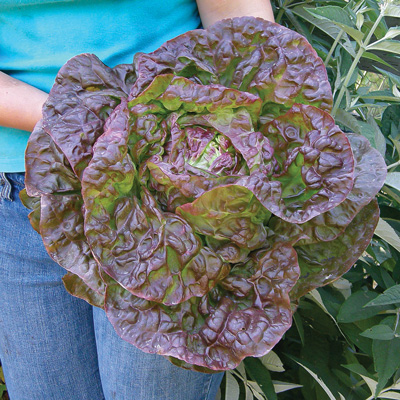
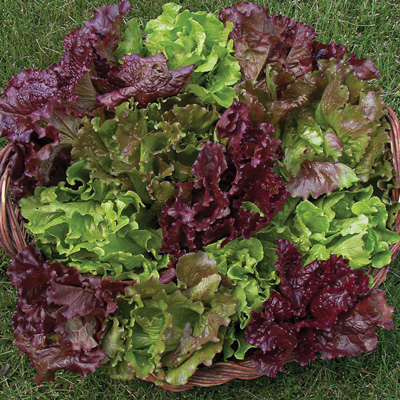
Iceberg lettuce is an American heirloom, notes Dr. William Woys Weaver in his book, Heirloom Vegetable Gardening. He says, “Homegrown Iceberg is one of our finest and most reliable summer lettuces.” Dr. Weaver is Curator Emeritus of The Roughwood Seed Collection and founder of The Roughwood Table, an award-winning cookbook author and food historian, and author of seventeen books. Roughwood has over one hundred growers in Pennsylvania and one in Uruguay. Hardy oak leaf can be overwintered in a cold frame. Rosettes are one to two feet across. Try some Dutch Speckled Butter, a butterhead/Bibb/Boston lettuce, once a Philadelphia greenhouse favorite. An unusual garden lettuce selection is called celtuce, aka stem lettuce, or asparagus lettuce (L. sativa var. asparagina). It is a favorite in China, grown for its tasty stem that is eaten raw or in stir-fries. Its young leaves are also edible. In Heirloom Vegetable Gardening, Dr. Weaver relates the circuitous arrival and use of celtuce in the US since the 1840s. It was a Mennonite plant collector from Lancaster, PA, who received seed and figured out that the stem is good eating. Says Dr. Weaver: “I obtained the seed from the Henry Doubleday Research Association near Coventry, England. I was at the time a member of the association. They only distributed seeds from their seed bank to members, so it was not widely available.” This strain of lettuce is ancient – depicted in ancient tombs, paintings on the walls. “I’ve eaten the stem part as a vegetable. I wanted to try it because it was an ancient lettuce.” Dr. Weaver’s favorite ways to use celtuce is pickling and in stir fry.
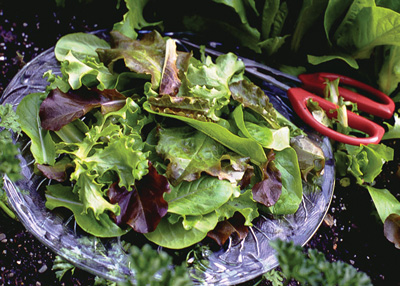
For delicious young leafy greens, the easy and intensive “Cut and Come Again” growing method yields the most greens in the smallest space in the shortest amount of time. “First thing to do is read the package back,” Shepherd insists. “There is information needed to be successful. It’s very important to read the lettuce packets.” Sow seed when danger of frost is over. Sow thickly in well-prepared soil. Use scissors to cut when four to five inches tall, leaving one-two inches. Water well and fertilize lightly for regrowth.
Start your lettuce in flats unless you are a plant nerd and are willing to direct sow and tend your seedlings every day. If you start seeds indoors, transplant when plants have five or six leaves; harden them off for four or five days then plant out. Do not crowds plants. Do not plant thickly except for “cutting” or cut and come again lettuces and Mesclun mixes. Crowding attracts pests and disease. Space about eight inches and large heading plants fourteen inches to give room to grow. Lettuce needs air circulation to prevent stem rot and to discourage slugs. The more sun on uncramped leaves, the more color and nutrients.
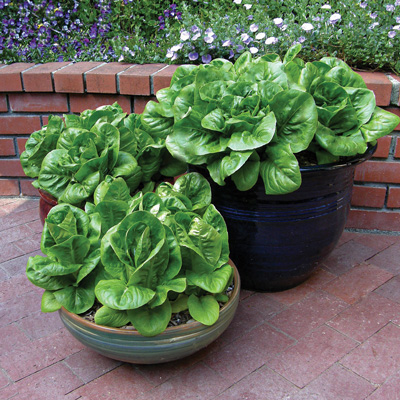
Be attentive to your lettuce plants. They are short-lived and if left unpicked for too long, they will flower (bolt) and the bottom leaves become bitter, especially in hot weather. But growers are very busy people and have discovered several varieties that can handle the summer heat with slower bolting patterns and resistance to insect damage. Selective breeding includes delayed bolting, larger seeds, larger leaves and heads, better taste and texture, and lower latex content.
How to grow celtuce: “Start seeds indoors and plant out when large enough to fend for themselves,” says Dr. Weaver. Because it is tall, plant about twelve inches apart. When the stem reaches eight to twelve inches tall, harvest as a stem vegetable. You can also eat the leaves. “It’s a two for one vegetable. Peel the bitter, outer skin right before using. Use the stem raw in salads, roasted or in a stir-fry.” The outer skin has a bitter, milky sap, mostly just under the skin, with similar effects as a very mild opiate. Cooking the stem neutralizes the chemical. When the stem is tall enough, the sap increases as the celtuce bolts. The sap is the plant’s natural protection against predators.
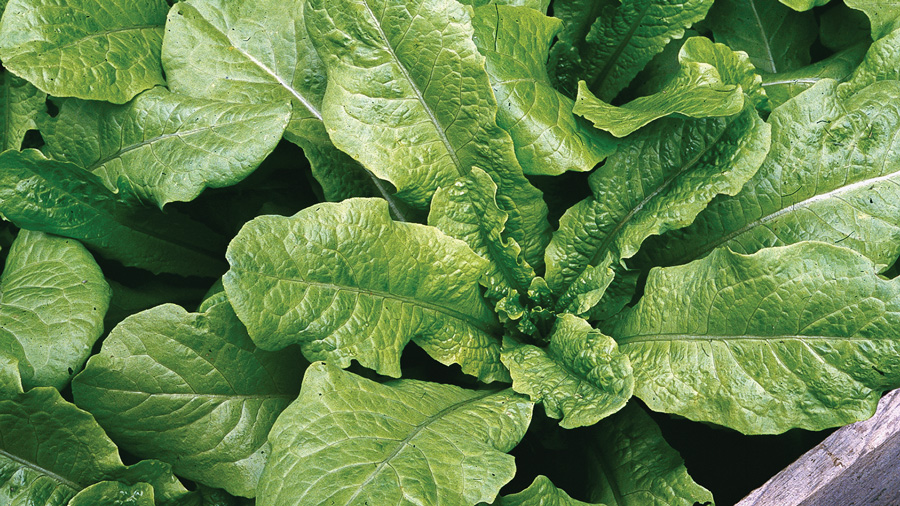
Where to grow your salad garden? If you have limited space or time or are new to gardening, try a Square Foot Garden, developed by the late Mel Bartholomew, civil engineer and author of Square Foot Gardening, the biggest selling gardening book in history. Simply put, it is a four-by-four-foot raised bed garden divided into sixteen squares, one square foot each (section them off with twine), all reachable from outside the garden. The theory is that everyone can reach two feet into the garden from all sides. No need to step on and compact the soil. It remains nice and fluffy for healthy plants. Weeding is easier too. The Square Foot Garden is no dig, no till, and easy maintenance, season after season. Give your children their own square and the gift of pride, knowledge and fun in growing their own dinner. You can plant lettuce almost year-round using the right varieties. Plant a salad garden with several kinds of lettuce and other salad goodies: herbs that you like in salads, sweet peas, sugar pod peas, radishes, baby spinach and chard, arugula, baby carrots, beets, grape tomatoes and cucumbers. Put climbers in the back so as not to shade the shorter plants. Classic square foot gardens are four-by-four but a two-by-two in a corner, say, on a deck, or a one-by-eight along a fence all work fine. Make it fit your personal convenience. Build them at least sixteen inches tall for all your veggies’ roots and, if need be, even higher to accommodate tired backs and wheelchairs. Most beds of this type are made with wooden boards or pallets. Make sure pallets say “HT” – heat treated – no chemicals. You can also make raised beds with rocks, bricks, cement blocks or any objects that will hold the soil in place. Dig out existing vegetation and roots; level the soil and place a good inch or so of cardboard and newspaper as a base. A good blend is six parts topsoil, three compost and one potting soil. Buy or build your own raised beds with plenty of DYI on YouTube.
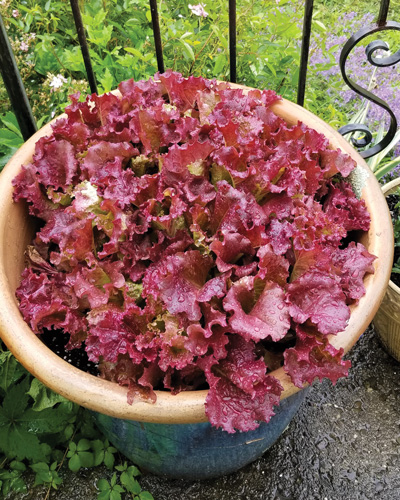
You can plant lettuce in containers placed anywhere in the sun, but close to a water source or install an irrigation system in the beds. Plant where deer won’t eat your dinner. This writer grows Loose Leaf French Redina and other goodies in large ceramic containers on her sidewalk right outside the kitchen door. This way, it’s easy to eat more healthy salads. Reach for the lettuce and not the cookie. Or plant in the ground in a fenced, traditional garden. The fence should be eight feet high to protect your garden from deer. Got a deck? Ceramic and terra cotta containers and whiskey barrels look great there, adding color, life, interest and convenience. They breathe, allowing air to the roots so the soil won’t get soggy and rot them. Soil Life Matters! For a good container mix, combine an organic, fertilizer-free potting soil and an organic compost. Fafard and Coast of Maine are great. Large containers grow better lettuce. They stay moist longer, which means no daily watering needed. Just be vigilant.
Dr. Weaver suggests that if you want to save your lettuce seed for next year, save it from your best lettuce and truest to the type and those that bolt last, which demonstrates more tolerance to warmer weather. Harvest your seed when the leaves turn yellow and the flower head begins to sprout. Cut off the flower heads and put them upside down in a paper bag. Mark the name and date and store in a dry, airy room out of direct sun. Let the seed mature for about a month, then gently remove the seeds from the head with your fingers. Then winnow (separate the seeds from the chaff) outside or indoors with a fan because soil, other seeds and plant parts might contain moisture and rot your seed while in storage. Check online for Ancient Winnowing Technique. Further, if you want to save seeds, Dr. Weaver recommends separating lettuce types in the garden because Open Pollinated lettuces cross, even with wild species. However, the plants themselves do not cross; their seeds do and the cross won’t show up until the following year. So, if you are growing your lettuce for your dining table instead of its seed, it doesn’t matter; you can plant them right next to each other. If you are growing for seed, you should also remove all wild and prickly lettuces in the area.
Did you know that New Jersey has eight species of “wild lettuce?” They are each a different species of Lactuca. Five are native. According to the NJDEP, Division of Parks and Recreation, two of them – Grass-leaf Lettuce and Red-stem Hairy Lettuce – one is imperiled and one is of uncertain status. Both are protected by the Highlands Water Protection and Planning Act in the Highlands Preservation Area. Wild lettuce’s cut stems exude a white milky substance (some varieties more than others) termed as latex and sometimes as “opium lettuce.” Some are notorious garden weeds that we have all seen. WebMd notes most have medicinal properties used for pain, stress, insomnia, nyphomania and other maladies via its milky sap. According to Dr. Hubert Ling, botanist and president of Native Plant Society of New Jersey, wild lettuce “is much too strong and has a lot of very bitter latex. The appealing feature of cultivated plants is that they are bred to have fewer natural defenses such as latex.” This writer thinks she will stick to French Redina and the multitude of other delectable cultivated varieties.
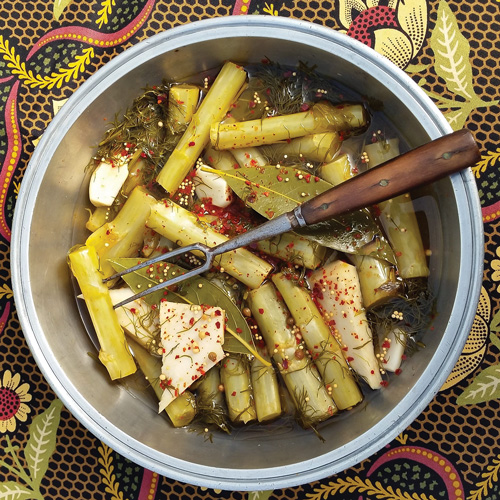
While the original recipe came to me via a friend in Poland, the concept of preserving stem lettuce is ancient in Central Europe, especially in the Balkans and regions formerly influenced by Byzantium. The technique is also well known in the Eastern Mediterranean, India, and even China, indeed anywhere that bolting lettuce is still viewed as a culinary opportunity. When lettuce bolts (runs to flower) it sends up straight, asparagus-like stems containing bitter milky sap. No longer palatable as a leafy green, these stems can still be transformed into useful food through cooking or pickling. Thus pickled stem lettuce was a villager’s remedy for salvaging something that otherwise would have been lost, in short, turning a crop shortfall into a pickle over plus.
Pickling stem lettuce negates the bitterness and offers a green vegetable for the winter table, especially as an additive to winter salads and soups. Pickled stem lettuce also makes a perfect addition to cheesy casseroles, or for an Asian twist, to spicy stir fries.
Strip off the leaves from the lettuce stalks (before they begin to flower). Remove the outer skin from the tougher parts of the stem (those close to the root end of the stem), and then slice into 2-inch segments. Place the sliced stems in a sanitized hot, 2-quart (2-liter) wide-mouth preserving jar along with the chopped dill, garlic, mustard seed, coriander seed, horseradish, and chili flakes. Bring to a full rolling boil over a high heat the water, white wine vinegar, and salt. Boil 3 minutes, and then pour this over the stem lettuce mixture. Seal and when at room temperature, set away in a cool dark place until required. While the shelf life is about 6 months, I recommend that you use pickled stem lettuce within 30 or 40 days. Lettuces are easy to grow and can be planted in 3-week successions so that there is a constant supply of leafy saladings and subsequent flower stems during the spring or early fall.